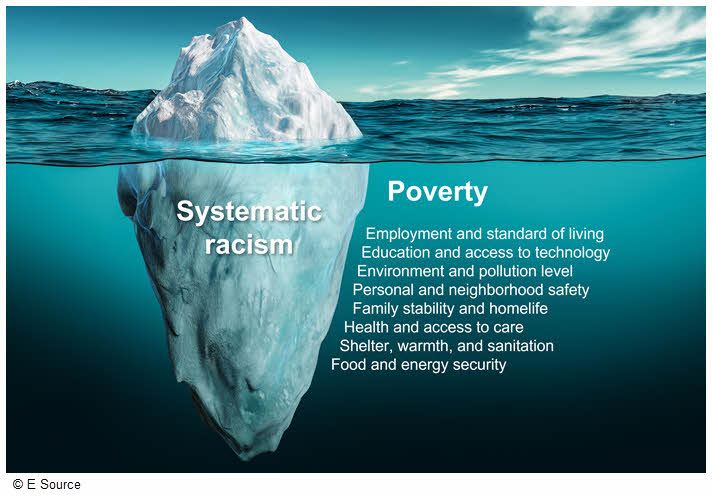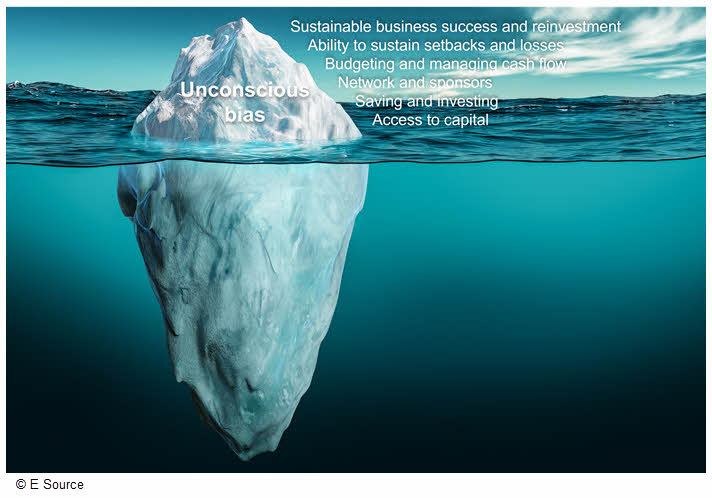Diversity, equity, and inclusion trainers often use the metaphor of an iceberg to teach participants how behavior is anchored to conscious and subconscious thoughts, beliefs, and experiences. Psychologist Sigmund Freud believed that the preconscious, existing just below the surface (like the mass of an iceberg, as explained in the article The Role of the Conscious Mind by Kendra Cherry), could influence conscious awareness and behavior—the small part of the iceberg above the waterline.
For organizations and individuals on the quest to create equity, having an understanding of the equity iceberg will help produce better strategies and tactics that address underlying issues and achieve sustainable results.
The equity iceberg
Some define equity as fair access to opportunity and resources—in essence, having the same level of access. But equality isn’t equity. Providing equal access doesn’t bridge the gaps created by systematic racism and discrimination, where Black, Indigenous, and people of color (BIPOC); women; and other groups have faced historic disadvantages.
The danger in confusing equality with equity is that you’ll be solving the wrong problem or oversimplifying the solution. For example, when addressing energy security, it’s common to assume that increasing participation in an energy-efficiency program is the silver bullet. If participation is lagging, the focus goes to program design and marketing to boost participation. In reality, a lack of participation may be a confluence of factors. For example:
- A lack of savings, time, or ownership of the dwelling affects the desire and ability to invest in energy efficiency.
- Older homes need weatherization measures before homeowners can make energy-efficiency upgrades.
- Adverse health conditions resulting from mold or other by-products of housing conditions result in unsteady employment and income.
To achieve equity by bridging historic gaps created by discrimination, we need to have a greater understanding of the confluence of factors and forces that facilitate progress. The first factor is that below-the-waterline needs are those impacted by systematic discrimination—historic policies, practices, and structures that impact access and opportunity, including employment, housing, healthcare, education, technology, and capital (figure 1). Much of the existing infrastructure designed to bridge gaps prevents progress because of how access is designed.
Figure 1: Below-the-waterline needs of the equity iceberg
The second factor is that problems impeding progress are interdependent and aren’t solved by addressing symptoms. Sustainable equity solutions are rooted in understanding two dynamics of below-the-waterline needs:
- Lower-level deficit needs must be satisfied in order to progress to meet higher-level growth needs. This is described in Maslow’s Hierarchy of Needs. It doesn’t mean that you need to meet each level completely before going on to the next level. For example, it’s possible to maintain a job while struggling with energy insecurity and suffering with health issues because of poor living conditions. But rising from employee to business owner hinges on more of those underlying needs being met.
- Conditions in the environment where people are born, live, learn, work, play, and age affect their health, functioning, and quality-of-life outcomes and risks. Equity is achieved not just by satisfying individual needs but by addressing the environment where the individual operates. For example, launching a successful small business depends as much on participants as its investment in the surrounding neighborhood and neighbors (safety, beautification, energy and food security, pollution reduction, employment, etc.). The result is more likely to be a healthy business in a thriving neighborhood where people want to (and can afford to) shop.
Under-the-waterline needs
Disproportionately, ethnic and gender gaps exist in underlying needs. Unraveling historic inequity takes targeted investment and integrated approaches to address more-basic needs sequentially to stabilize communities.
Food and energy security. Food and energy are basic human needs that if left unfulfilled affect every other aspect of existence. For example, educational gaps of disadvantaged students are more successfully bridged if they have proper nutrition, have a place to sleep, and have a safe and harmonious homelife. And while food has always been recognized as a basic need, energy is a more recent addition. According to Energy Insecurity by Columbia University’s Dr. Diana Hernández, there’s a correlation between food and energy insecurity. If you can eliminate one, the remaining insecurity is more easily addressed. But someone battling both often isn’t able to shoulder the burden alone.
Environmental conditions. After making a neighborhood safe, the community can start making the neighborhood healthier and cleaner. Formerly redlined neighborhoods and borderline communities often suffer from decades of disinvestment and proximity to manufacturing plants and expressways, creating food deserts as well as excessive levels of heat and pollution compared to nonredlined areas. These lead to poor air and water quality that creates and compounds adverse health conditions.
Education and access to technology. The quality of education and access to technology is most often dependent on the property tax base, affluence of the community, and demand of the residents. Disadvantaged communities are often in survival mode and experience an education and technology gap. After-school and summer programs are effective in improving test scores and creating parity, but it’s important to first address issues such as food and energy insecurity, homelessness, weatherization, and safety so students can fully participate.
Above-the-waterline results
When under-the-waterline needs are met, it’s more likely that disadvantaged communities are better equipped to thrive and community members achieve financial independence. Above the waterline is the territory of home and property ownership; more responsibility, leadership, and salary at work; capital to open a business, networks, and exposure to grow that business; and even owning and controlling capital investment in other companies. Although systemic discrimination does play a role in preventing above-the-waterline results, we more often attribute the lack of diversity in this area to more-subtle and nuanced reasons such as unconscious bias and lack of intercultural competency (figure 2).
Figure 2: Above-the-waterline challenges of the equity iceberg
Achieving results above the waterline involves not only the education, exposure, and effort of diverse individuals, but also changing the hearts and minds of those in power to get past historic barriers in judgment, risk tolerance, and cultural differences. Getting to greater levels of parity in prosperity means addressing the following issues.
Budgeting and managing cash flow. Money management is often something that’s caught, not taught. Budgeting classes aren’t required for high school or college graduation, but budgeting is the foundation of financial success. And parents treat their children differently when it comes to money, as described in the Fast Company article How parents talk about money differently to their sons and daughters. They teach girls “fiscal restraint,” while they teach boys how to build wealth.
Saving and investing. In 2016, the average net worth of white families was $171,000; for Black families, that average was $17,150, according to Examining the Black-white wealth gap by the Brookings Institute. The difference is generational wealth—“White families receive much larger inheritances on average than Black families”—and you have to have money to make money.
Access to capital. Like most small business owners, minority-owned businesses need access to capital. The difference is that minorities face additional barriers to getting that capital. When the US government offered Personal Paycheck Protection (PPP) loans to help small businesses through the pandemic, 90% of women- and minority-owned businesses didn’t get loans. Why? According to the Crain’s Chicago Business article Pandemic-inspired small-business loans expose inequities that must be fixed, the PPP loans were available through private-sector lenders, but minorities don’t have established relationships with banks.
The equity iceberg in action
Leading utility foundations are supporting social justice in their communities by transforming their investment focus areas, frameworks, metrics, and measurement. What can we learn from their efforts, and how can you draw inspiration for your own foundation? As discussed during the 2021 E Source Forum session How utilities are supporting the most significant social movement since civil rights, the equity iceberg underpinned Alabama Power’s and Mississippi Power’s approaches to equity. For more, watch the session recording.

